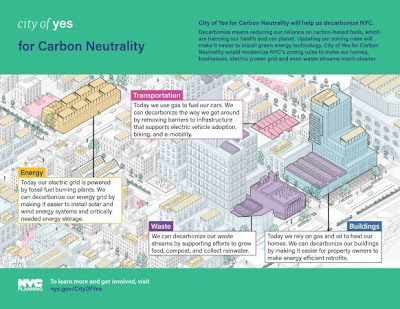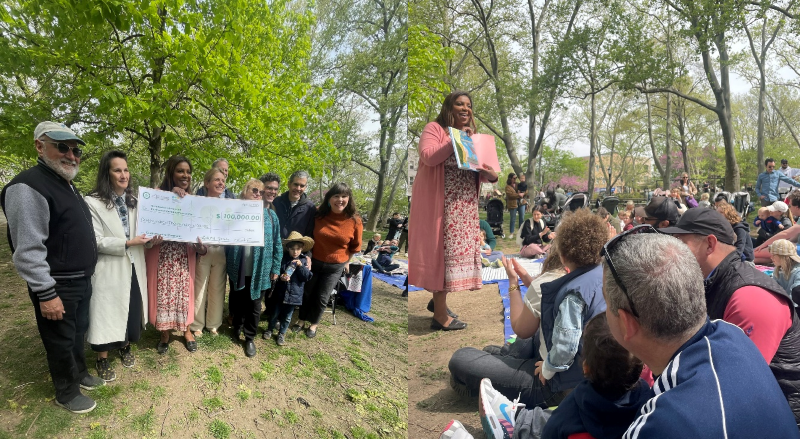“City of Yes for Carbon Neutrality” Will Remove Zoning Barriers to Greener Energy, Buildings, Transportation, and Water and Waste Systems
Proposal Would More Than Double City’s Solar Energy Capacity, Help Reach Goal of Powering 250,000 Homes With Solar
“City of Yes for Carbon Neutrality” Will Remove Zoning Barriers to Greener Energy, Buildings, Transportation, and Water and Waste Systems
Proposal Would More Than Double City’s Solar Energy Capacity, Help Reach Goal of Powering 250,000 Homes With Solar
New York City Mayor Eric Adams and New York City Department of City Planning (DCP) Director and City Planning Commission (CPC) Chair Dan Garodnick today celebrated a major milestone for “City of Yes for Carbon Neutrality,” the first of Mayor Adams’ “City of Yes” proposals. City of Yes for Carbon Neutrality is a citywide zoning amendment that, with 17 policy proposals, will modernize the city’s Zoning Resolution to facilitate climate action, clean energy, and resiliency by removing barriers to greener energy, buildings, transportation, and water and waste systems.
DCP today officially referred the City of Yes for Carbon Neutrality text amendment, kicking off a public review process in which the text amendment will go before all 59 community boards, all five borough presidents and borough boards, the City Planning Commission, and the City Council. Community engagement materials and high-resolution images are available online.
“Today, New York City is saying ‘yes’ to a cleaner, greener, more prosperous future for generations to come,” said Mayor Adams. “This proposal will make it easier to tackle climate change in the places we go, how we get there, and what we do. The climate crisis is urgent, and I look forward to talking to New Yorkers about how we can remove barriers, take action, and ensure a healthy future for our neighborhoods, our city, and our planet.”
“Meeting our ambitious climate goals requires a whole-of-government approach, including updating our own regulations,” said Deputy Mayor for Economic and Workforce Development Maria Torres-Springer. “I am excited to take this important step forward and encourage New Yorkers to say ‘yes’ to changes that will enable us to be a greener and healthier city.”
“New Yorkers want to do the right thing for our city and planet, and City of Yes for Carbon Neutrality will make it easier than ever to take climate action,” said Deputy Mayor for Operations Meera Joshi. “Removing outdated zoning barriers will give New York City the tools to create a robust electric vehicle charging network, expand the installation of rain gardens and permeable pavement to prevent neighborhood flooding, and support New Yorkers who install solar panels on their homes.”
“This is a critical initiative to meet our climate goals,” said DCP Director and CPC Chair Garodnick. “By modernizing our zoning code for climate action, we can reduce our carbon emissions, support our resiliency efforts, and set New York City up for success in the clean-energy revolution. By updating our 20th-century zoning code to address the 21st-century climate crisis, we can cut through the red tape that prevents New Yorkers from cutting emissions and electrifying our buildings and transportation. We look forward to a robust public review process as we move toward a cleaner, greener city for all.”
An illustration of the ways City of Yes for Carbon Neutrality will remove zoning barriers to greener energy, buildings, transportation, and waste streams. Credit: New York City Department of City Planning
City of Yes for Carbon Neutrality is one of three citywide zoning text amendments that Mayor Adams outlined last year as part of his vision for a City of Yes. The other two text amendments will support small businesses and entrepreneurs (“City of Yes for Economic Opportunity”) and facilitate the creation of more, and different types of, housing (“City of Yes for Housing Opportunity”). Today’s referral follows the completion of another major component of the mayor’s City of Yes vision: the “Get Stuff Built” report put together by the Building and Land Use Approval Streamlining Task Force.
The initiative comes as New Yorkers can take advantage of the federal government’s historic investments in clean energy through the Inflation Reduction Act and as the city works to meet ambitious environmental goals such as those in Local Law 97. These opportunities build upon existing programs to assist New Yorkers, including from NYC Accelerator — which has already provided one-on-one building-specific guidance on Local Law 97 obligations to nearly 10,000 buildings — as well as Con Edison, the New York State Energy Research and Development Authority, and state tax credits.
City of Yes for Carbon Neutrality will update outdated regulations that currently make it harder for New Yorkers to retrofit their homes for energy efficiency or resiliency, install heat pumps or solar panels, switch to electric vehicles, or compost and recycle — all critical steps for New York City to reach its ambitious environmental goals.
The zoning text amendment consists of 17 policy proposals, including:
Plan for a Renewable Energy Grid: This initiative would remove existing zoning obstacles that severely limit how much space on a rooftop can be covered by solar panels, unnecessarily slowing the city’s shift towards renewable energy sources. It would also make it easier to install energy storage infrastructure needed for solar energy and facilitate standalone, grid-supporting solar and community microgrids — particularly in low-income communities — that are currently banned in residential areas.
These changes would open up over 8,500 acres of parking lots across the city for potential use of solar panels. If fully built out, these solar panels could power more than 130,000 homes.
Create Cleaner Buildings: The text amendment would alleviate onerous restrictions such as the height and thickness of walls that restrict building electrification and retrofits. This proposal would add flexibility making these modifications possible while maintaining the look and feel of the city’s neighborhoods.
These changes would facilitate environmentally friendly retrofits for over 50,000 buildings, including more than 1 million homes, where retrofits are currently infeasible and would violate city zoning.
Support Electric Vehicles and Micromobility: This proposal would more than double the commercially zoned land where electric vehicle charging facilities can be located. It would also clarify regulations and facilitate safe bicycle and e-mobility parking.
These changes would make electric vehicle charging possible in more than 400 million additional square feet.
Modernize Water, Compost, and Recycling Regulations: This initiative would expand the use of permeable paving and rain gardens, cut red tape and eliminate uncertainty for recycling and composting, and encourage rooftop food production.
These changes would contribute to the city’s efforts to divert the 34 percent of New York City’s residential waste — and as much as 45 percent of all solid waste — that is organic material from landfills to beneficial use.
The text amendment will now be referred to all 59 community boards, all five borough presidents, and all five borough boards for review and recommendation within 60 days. After those 60 days, the City Planning Commission will hold a public hearing and vote. If the commission approves the amendment, it will go to the City Council for a hearing and vote.
“New Yorkers have been witnesses to the rising sea levels and more intense storms that climate change is bringing to the five boroughs, and the City of Yes for Carbon Neutrality will help them do their part to slow this trend,” said Chief Climate Officer and New York City Department of Environmental Protection Commissioner Rohit T. Aggarwala. “By removing outdated regulations, we will help to expand the use of solar energy, electric vehicles, building electrification, and a circular economy for organic waste, all of which will help to slow climate change.”
“This zoning amendment will make New York a ‘City of Yes’ for climate adaptation and decarbonization,” said Mayor’s Office of Climate & Environmental Justice Executive Director Kizzy Charles-Guzman. “Solar and energy storage will become more economical, and there will be easier pathways for green and grey infrastructure — all of which will reduce emissions and improve air quality and health.”
“The electric needs of our city are changing every day, and we know green energy and renewable energy are not just the future, they are initiatives that are here right now,” said Fire Department of the City of New York (FDNY) Commissioner Laura Kavanagh. “The FDNY is committed to finding safe ways to use these changing technologies, and we are happy to partner with the Mayor’s Office on a plan that will make our city cleaner, greener, and more energy efficient.”
“New York City continues to be national leader in sustainable, resilient, and forward-thinking urban planning,” said New York City Department of Buildings Acting Commissioner Kazimir Vilenchik, P.E. “With the proposed zoning changes from the City of Yes for Carbon Neutrality, the Adams administration will remove outdated building regulations, so owners can more easily retrofit their buildings. These energy-efficiency retrofits will be critical as we work towards our ambitious goal of carbon neutrality by 2050.”
“It’s time to rethink old rules and develop new solutions to confront the reality of climate change today,” said New York City Department of Housing Preservation and Development Commissioner Adolfo Carrión Jr. “City of Yes for Carbon Neutrality will supercharge our work to decarbonize existing buildings and create more sustainable housing for New Yorkers. Let’s say ‘yes’ to a greener, cleaner future for New York City.”
“City of Yes for Carbon Neutrality will make it easier for all New Yorkers, including those in landmark properties, to retrofit their buildings for energy efficiency and resiliency,” said Landmarks Preservation Commission (LPC) Chair Sarah Carroll. “LPC supports efforts to improve the energy efficiency and sustainability of New York City’s historic buildings and commends the Adams administration and the Department of City Planning for proposing important zoning changes that will help New York City achieve its ambitious carbon neutrality goals.”
“Convenient access to electric vehicle charging is crucial to encourage broader adoption in New York City,” said New York City Department of Transportation Commissioner Ydanis Rodriguez. “These proposals would not only help expand charging infrastructure but also improve access to bicycle and e-micromobility parking by better clarifying related zoning regulations. We thank Mayor Adams and DCP Director Garodnick for their support in using zoning regulations to reduce emissions in the transportation sector and support more sustainable transportation options for New Yorkers.”
“For too long, the city’s zoning regulations prohibited buildings from making necessary green investments to fight climate change and cut down on toxic air pollution. That’s why the New York League of Conservation Voters supports New York City’s proposed City of Yes for Carbon Neutrality zoning text amendment,” said Julie Tighe, president, New York League of Conservation Voters. “This measure is a critical opportunity for New York City to modernize its zoning resolution to support the city and state’s climate goals and improve air quality and public health by reducing the use of fossil fuels in our building and transportation sectors.”
“This needed initiative will modernize New York City’s zoning rules to accelerate building decarbonization,” said John Mandyck, CEO, Urban Green Council. “The proposals are informed by industry experts with practical solutions to achieve greener, safer, and more resilient solutions to climate change. We applaud Director Garodnick and the dedicated team at City Planning for moving this crucial effort forward.”
“Given the threat that climate change poses to our city, there is no time to wait,” said Rob Freudenberg, vice president for energy and environment, Regional Plan Association (RPA). “Whether installing more solar panels or electric vehicle charging stations or retrofitting buildings to better comply with Local Law 97, zoning should not be an obstacle to taking actions that reduce our city’s greenhouse gas emissions and help us meet our climate goals. RPA strongly supports the launch of the City of Yes for Carbon Neutrality by Mayor Adams, Chair Dan Garodnick, and the Department of City Planning and City Planning Commission, and we look forward to working with them in their crucial effort to right-fit our zoning to the climate realities we face today.”


